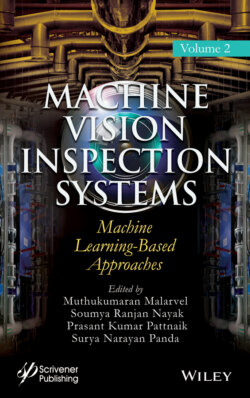Читать книгу Machine Vision Inspection Systems, Machine Learning-Based Approaches - Группа авторов - Страница 13
1.1 Introduction
ОглавлениеML [1–34] plays an important role in the today’s era for the researchers and scientists to carry out their research work. ML is considered as one of the most important application of artificial intelligence. Systems can be learned and improved from experience in automatic manner without any explicit programming by using ML mechanism. The main focus of ML is to develop computer programs that can access data as well as use it for learning purpose. ML techniques can be mainly classified as unsupervised learning techniques and supervised learning techniques. Unsupervised learning techniques focus on clustering techniques and supervised learning techniques focus on classification techniques. Hierarchical clustering, distance map, distance matrix, DBSCAN, manifold learning, k-means, Louvain clustering, etc. are some ML-based clustering techniques. ML [1–34] focuses on several classification techniques such as LR, NN, kNN, NB, decision tree, random forest, AdaBoost, etc. The similar objects can be grouped into a set which is known as cluster by using clustering techniques. Classification techniques are used to categorize a set of data into classes. In classification technique, the algorithm can learn from the data input provided to it and then use this learning mechanism to classify new observations. These techniques are mainly used to categorize the data into a desired and distinct number of classes where label can be assigned to each class. It is a very challenging task to categorize the set of data into classes accurately. Several ML-based classification techniques can be used for such classification. Viruses [57, 58] are the submicroscopic infectious agents and they are having the replication capability due to which they replicate itself inside the living cells of human body. Viruses can be classified as DNA and RNA viruses on the basis of nucleic acid, cubical, spiral, and radial symmetry, complex viruses on the basis of structure, bacteriophage, plant and animal, insect viruses on the basis of host range. Several viruses can be transmitted through respiratory route, feco-oral route, sexual contacts, blood transfusion, etc. Very dangerous viruses such as SARS-CoV-2, EV, ENV, LV, ZV, dengue virus, Hepatitis C virus have adverse effects which greatly affect the human society in the current scenario. In this work, several ML-based classification techniques such as LR, NN, kNN, NB are focused for the implementation of classification mechanism on several TEMVIs such as EV, ENV, LV, SARS-CoV-2 and ZV.
The main contribution of this work is stated as follows.
ML-based approach is used for the processing of several TEMVIs such as EV, ENV, LV, SARS-CoV-2 and ZV.
ML-based approach focuses on several classification techniques such as LR, NN, kNN and NB for such processing.
These techniques are compared using the performance metric such as CA.
This work is carried out using Orange3-3.24.1.
The rest of the chapter is organized as follows. Section 1.2 describes related works, Section 1.3 describes methodology for the processing of TEMVIs, Section 1.4 describes results and discussion and Section 1.5 describes the conclusion.
